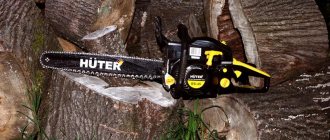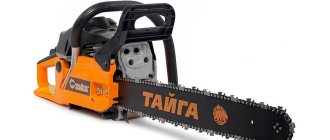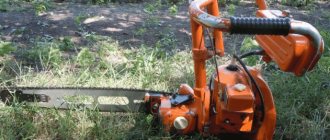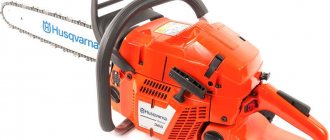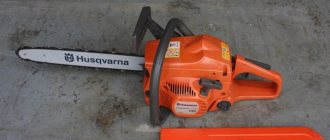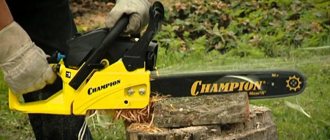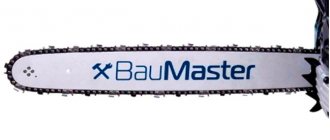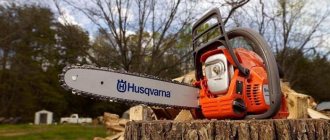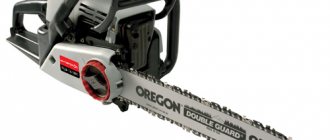Chainsaws Taiga
The history of Taiga chainsaw production dates back to the Soviet Union. Chainsaws were produced as a counterpoint to Ural devices.
Chainsaws Taiga
The production of saws took place at the plant named after Degtyarev (ZID) and F.E. Dzerzhinsky since 1955. After the collapse of the USSR, new models did not go on sale; the plant sold old developments and only resumed work on creating new designs in the early 2000s.
The creation of Taiga chainsaws is carried out on the basis of the production facilities of the Taiga company. The company's specialization covers mechanical engineering and the production of garden equipment.
The Taiga line of chainsaws is represented by models for professional, semi-professional and household use. Many devices are designed as semi-professional ones and are used most often in everyday life.
You can use Taiga chainsaws:
- at logging enterprises;
- on a suburban area;
- in the garden;
- in construction.
Basic equipment of Taiga chainsaws:
- Taiga chainsaw;
- tire;
- chain;
Taiga chainsaw kit
- plastic protective cover (included in new models);
- a set of tools for assembling and setting up the saw;
- container for mixing fuel fluid (not available on all models);
- instructions;
- warranty card.
Taiga chainsaws most often arrive on shelves in only one configuration: standard with a single set of parts. It is very rare to find a kit with an additional set of saw parts.
Chainsaw Taiga 214
This tool is in great demand due to its durability and reliability. It is successfully used in public utilities, construction, and households. The design of such equipment makes it easy to cope with cutting wet and freshly cut wood. In addition, the saw will show excellent results when performing work such as:
- bucking of whips;
- cutting down small trees;
- croaker filing;
- pruning;
- firewood preparation;
- sawing old boards.
Technical characteristics of Taiga 214:
- power: 3.5 hp
- engine: 2-stroke
- tire length: 38 cm
- fuel consumption: 440 g/l.h.h
- engine volume: 75 cm3
- oil tank: 0.25 – 0.3 l
- weight: 8.8 kg
- dimensions: 857x280x272 mm
- fuel tank: 0.8 l
- noise level: 106 dB
Features of the Taiga 214 chainsaw:
- good performance;
- endurance;
- reliability;
- automatic oil supply;
- comfortable work with the tool;
- high maintainability.
Description
Taiga chainsaws are high-quality domestic equipment that can be used both on an industrial scale and at home. Most Taiga models are made on the basis of metal parts, which is why they weigh more than their analogues.
Chainsaw Taiga at work
Most owners prefer Taiga chainsaws, as they are easy to operate and do not require additional repair costs. You can replace all components or adjust the carburetor yourself without contacting a service center.
Taiga chainsaws are classified:
- professional;
- semi-professional.
The second type is intended for use in industry and suburban areas.
The classification of products in the model range depends on:
- technical characteristics;
- product weight;
- power;
- quality and component manufacturer.
Some products in the Taiga line of chainsaws are equipped with Walbro carburetors. This is an American company that specializes in the production of carburetors for various equipment, including chainsaws.
Japanese Walbro carburetors
Walbro has many subsidiaries in different countries: Mexico, Japan, China. When creating Taiga chainsaws, the Soviet Union entered into an agreement for the supply of carburetors from Japan. Today, Walbro carburetors are supplied to Taiga from China, Japan and the USA.
Walbro is the most trusted and experienced manufacturer of two-stroke carburetors in the world.
Manufacturer of chainsaws: USSR, Russia.
Repair and adjustment of the Taiga chainsaw carburetor
Your chainsaw is equipped with a Walbro carburetor, which can also fail and require repair. Most often, repair work consists of cleaning the carburetor of debris or adjusting it.
If your chainsaw loses power, has trouble starting and stalling, or won't start at all, you need to adjust the carburetor. The adjustment process does not take much time and does not require special knowledge and skills. The carburetor is adjusted using a thin screwdriver, three screws marked H, T, L, which are responsible for the supply of fuel and air. You can learn more about the process of adjusting and repairing a Walbro carburetor in this video:
Video
The lineup
Initially, several versions of the chainsaw were created on the basis of the ZID, which differed:
- engine power;
- productivity;
- efficiency.
Heavier and more powerful ones were intended for industrial use. It is worth noting that the basis for all subsequent products in the line was 1 development: Taiga 214. Today the plant produces several improved models, lighter and easier to operate.
Chainsaw Taiga 214
Modern chainsaws are equipped with additional functions, such as soft start, emergency stop, continuous fuel supply, etc. Another difference is weight; chainsaws have become lighter due to the replacement of heavy metal parts with durable and lightweight plastic.
The Taiga chainsaw range includes:
- Taiga 214. First model. Intended for industrial and economic use.
- Taiga 245 (semi-professional saw for household use).
- Taiga BP-3650 (household model).
- Taiga BP-3850 (semi-professional tool).
Chainsaw Taiga BP-3850
Chainsaw Taiga TBP-4400 1
- Taiga TBP-4000.
- Taiga TBP-4400/1.
- Taiga TBP-4500.
- Taiga TBP-6300 (professional saw).
The first models 214 and 245 were developed back in the USSR and for that time they were powerful, reliable saws. Today these devices are morally outdated. It is unprofitable to use them in construction and industry. As for more modern models, they are recommended to be used for domestic needs. Some chainsaws, for example, TBP-4000, are not designed for cutting branches, as they are too heavy and cannot be used with outstretched arms.
Top models
Even 6-8 years ago, when choosing the most popular models of the Taiga brand, the 245 chainsaw would have been included in this list. Today, this saw is morally outdated against the backdrop of foreign and domestic developments.
Chainsaw Taiga 245
But among the many shortcomings, it is worth highlighting one main advantage of this device - reliability. Many summer residents still use Taiga 245, purchased back in the USSR. When choosing flagships among the new models, we can highlight: TBP-4000, TBP-6300 and BP-3650, BP-3840. Let's take a closer look at these models.
Taiga TBP-4000
Taiga TBP-4000 is one of the manufacturer’s most popular models. The power of this device is 4.0 kW, the length of the bar is 45 cm. Many owners use a 50 cm bar when working; the power of the saw is enough for this.
Chainsaw Taiga TBP-4000
Using a chainsaw, you can cut trees with a diameter of up to 70 cm. A full tank of fuel is enough for 30-45 minutes of continuous work. This saw is semi-professional, but is often used in logging operations. This saw is not suitable for garden work due to its heavy weight - 6.5 kg.
Taiga TBP-6300
This chainsaw is professional, its power is 6.3 kW. This saw is not suitable for sawing large amounts of wood, so it is rarely used in the forest.
Chainsaw Taiga TBP-6300
With prolonged use, it quickly heats up and loses power, but works well in sub-zero temperatures. The design has been improved with several additional features. A detailed review can be found here.
Taiga BP-3650 and 3850
Taiga BP-3650 and 3850 are small household chainsaws. BP-3650 is compact and easy to operate; it differs from the subsequent model in being slightly heavier (6.5 kg).
Chainsaw Taiga BP-3650 Chainsaw Taiga BP-3850
Taiga BP-3850 is a more powerful and lighter model, its weight is 5.5 kg. The saw is suitable for harvesting firewood of various densities and copes well with frozen wood. These models are available in two variations: with and without a set of additional saw parts.
User manual
The operating instructions include the following points:
- Recommendations for working with the device.
- Recommendations for using the fuel mixture. To refuel a chainsaw, you need to prepare a special mixture, strictly adhering to the proportions. For fuel, you need to mix AI-92 gasoline with some oil. If the correct and necessary ratios of components are not observed, there is a risk of carbon deposits appearing on the cylinder, which will negatively affect the service of the gasoline saw tool.
- Safety precautions.
- Recommendations for maintenance.
First launch and run-in
When the fuel mixture is ready, the chain tension is assembled. Fuel and oil tanks are filled with appropriate fluids. The chain saw starts, the operator adjusts the idle speed and controls the supply of lubrication to the chain.
Proper preparation of the fuel mixture
For break-in it is necessary: mix the fuel mixture in a ratio of 50/2, use reduced loads on the engine (no more than 50%), run-in for a period equal to the use of 4 full tanks of fuel.
Maintenance
Maintenance includes:
- timely replacement of oil and fuel mixture (every 3-4 weeks);
- carrying out inspections for defects before and after work;
- cleaning of structural parts;
- replacement of parts.
It is recommended to choose original parts or similar ones from other manufacturers as replacement elements. As for oil, mixtures for two-stroke engines are excellent.
Basic malfunctions and ways to eliminate them
| Breaking | Cause | Solution |
| The saw does not start or gradually stalls. | Blockages in the fuel system or carburetor. Oil getting into the fuel membrane. The spark plug or ignition module is faulty. | Inspect and clean structural elements. If necessary, replace failed elements, a spark plug or a module. Fill the engine with the fuel mixture and run it at idle speed. Advice! A working spark plug will have a sandy color until it is cleaned. |
| The fuel filter is not working. | The fuel filter becomes dirty. | Replace the fuel filter. It is recommended to carry out the replacement procedure every 3 months. |
| The chain rotates without stopping. | Incorrect carburetor adjustment, clutch spring burst. | Inspect the engine and carburetor, ignition system. Replace the clutch spring and adjust the carburetor. To check, run it at idle speed. |
Depending on the model, breakdowns may vary. Due to the lack of additional systems, older models fail less often, but require frequent carburetor adjustments. It is worth noting that all models have the ability to sharpen the saw chain, which reduces the frequency of its replacement.
Features of the Chinese chainsaw carburetor
Their design and parameters differ depending on the power and model of chainsaw they are intended for. All of them are almost identical to the original carburetors in design, but not always in quality. Today, all Chinese products cannot be considered 100% rubbish. In turn, according to their quality, they can be divided into three groups:
- Poor quality. Unsuitable alloys are used which oxidize, crumble and break. There is no accuracy of fit, the calibrated holes do not correspond to the required values, which leads to excessive consumption or lack of fuel in the combustion chamber. Critical parts quickly fail. Plastic parts quickly become rough or, conversely, become softened by gasoline and stop working. The axles and wire rods are bent, the threads of the fasteners are torn off. Such products are the cheapest. They are made in semi-handicraft industries using adapted equipment. As a rule, they do not have a name or marking.
- Carburetors are of average quality. These are factory assembled products. They do not skimp on alloys; they have established continuous production with quality control. These are fully functional carburetors that can have a service life even longer than that of the entire chainsaw.
- High quality carburetors. First of all, these are products from global manufacturers whose facilities are located in China. Geographically, they can be considered Chinese, but they are made using the technologies of the company that owns the brand and values its reputation. For example, Japanese Walbro carburetors are produced in China.
Owner reviews
Andrey, Moscow:
“Domestic manufacturers sometimes produce high-quality and indestructible chainsaws, for example, Taiga 245, manufactured in 1990, and it still works at my parents’ dacha. Two years ago I bought a TBP-6300, of course the quality is not Soviet, but it’s a good saw. We use it to prepare firewood, and haven’t had to change anything yet.”
Vladislav, Khabarovsk:
“I bought a 4500 for myself – it’s a good chainsaw. Excellent for working in suburban areas. As for the lack of bells and whistles, it works well without them, the main thing is that it doesn’t break. I've been using it for three years now. Unpretentious in fuel and oil. Pros: reliable, unpretentious. Cons: none.”
